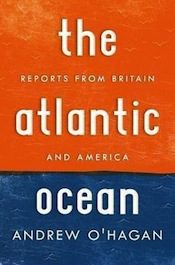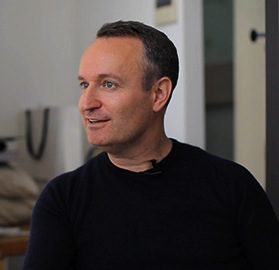
In a recent, short article, I itemized a few need-to-know UK-based writers; almost inevitably, someone took umbrage with my exclusion of certain names. A few suggestions were not known to me—though they were prominent and successful in their native land. I pondered how it is culture gets exported across the ocean—how successful game shows can get syndicated within a season, or tabloid media in the UK regularly chase down Pitt-Jolie, but one of the world’s greatest living essayists, Andrew O’Hagan, is not yet a household name in North America.
O’Hagan has written for the London Review of Books for twenty years and is also a successful novelist and dramatist. Much (though not all) of O’Hagan’s material has oriented itself in literature and within the UK (his birthplace is Scotland, and he resides in London). O’Hagan has just signed on to contribute regularly for the Times, so his reputation as a literary critic will continue to grow. But The Atlantic Ocean, an anthology of essays from the past 20 years that was published in the UK in 2008, has just been released in North America, and that is the real news, as this book encompasses the breadth of depth of his oeuvre: it includes plenty of London and plenty of literature, yes, but it also covers the Iraqi war, Marilyn Monroe, Andy Warhol, James Baldwin, Hurricane Katrina, the demise of farming, metero magazines, and more.
The title serves as a metaphor for both the physical distance, and the cultural ebb and flow, between US and British cultures. However, the book opens not into an expansive but rather a claustrophobic setting: by the Liverpool train tracks, just out of CCTV range. O’Hagan recounts his (and the public’s) reaction to the infamous murder of a toddler by a pair of ten-year-old boys in 1993. The case was noted for the defendants’ shocking youth and for the justice system’s unpreparedness in handling child offenders. O’Hagan’s essay divulges how struck he felt by the ordinariness of the two accused, how banal violence was for him in his youth. He confesses to terrible acts he and his friends performed with other friends and helpless animals, out of sheer lack of anything else to do, and countless unsupervised, unstructured hours to fritter away. As he announces elsewhere in the book: “There is something very English in the marriage of boredom and catastrophe.”
This essay makes for an unsettling introduction, not only in what it shares but in what it demands. O’Hagan’s gift as an essayist is not only for argument, but for developing the reader’s capacity to feel enormous empathy. Through his own confession, we are forced to trust a seemingly morally ambiguous narrator, yet we are also forced to remember whether we ever did anything cruel or senseless in our youth, something that could have all too easily escalated; whether we knew anyone who was dangerous, who could have led us down the dead end of violence in the name of fun. Are any children truly innocent? And the adults outside the trial, calling for the boys to be hung—are they justified in their blood-thirst? Did these kinds of people perhaps create this kind of children?
O’Hagan, like any good artist, asks open-ended questions of his audience. But he also makes firm assertions: he lays a lot of blame for societal change and breakdown on the ascendancy of Thatcherism/Reganism. The widely accepted (and long-debunked) myth of “trickle-down-economics” perhaps didn’t invent, but bolstered, some part of the stingiest part of a people’s spirit, and assuaged any shame that people may have felt over the primacy of “self-interest.” Thus we have, in “On Begging,” a thorough exposé of homeless people trying to navigate the social safety net, which like a sieve is designed for dripping.

Since that era, rampant homelessness has remained a normalized feature of our daily lives, in major cities on both continents. We don’t have to consider what the presence of street people says about us, or how easy it may be to wind up there; instead, we devise handy post-rationalizations for why we need not help. This logic is revealed in O’Hagan’s original online post of this essay at the London Review of Books site, in 1993. Someone commented (I paraphrase): ‘You’ve given me one more reason not to give to homeless people; after all, they could merely be journalists in disguise.’ The only other comment on the article, for good measure, was from the great essayist Christopher Hitchens, who shares an anecdote about a vegetarian politician who didn’t give handouts in case the needy spent it on meat!
In “The American Dream of Lee Harvey Oswald,” O’Hagan revisits the scene of the JFK assassination. At museums and historic sites, he is overcome by America’s ability to turn tragedy into identity—to make narrative out of senseless events. You could say this holds an appeal for him—after all, the narrative impulse is part of a writer’s synaptic structure. He is, however, repulsed at the triviality of people selling JFK trinkets along the grassy knoll—and perhaps this speaks to his guilt, as writers are thieves, somewhat, or at the very least opportunists. He warns more than once about the danger of permitting a writer into your home.
One reviewer called this book “an elegy for the pastoral,” but that is not expressly true. What makes this book so fascinating is that there are two knotted threads about the past that the reader must unravel, related to the public versus the private spheres of life. In terms of the public sphere—politics, economics, mass entertainment—O’Hagan feels Great Britain may have been better before, without so much foreign influence. In “On the End of British Farming,” O’Hagan demonstrates how domestic policies and international treaties have been devastating British production for decades.
But in terms of private life, O’Hagan most certainly has no nostalgia for Great Britain’s historical, fierce class divisions, having crawled out from the underbelly. “Everyone is middle class,” is something I remember Michael Moore saying with sarcasm, and something Romney said this past election campaign earnestly. England ascribes to this as well, as untrue as neighborhoods like Notting Hill prove it to be.
One of the most connective threads in this book—without ever saying that dirty word—is class. In an essay that served as an introduction to James Baldwin devastating book, Go Tell it on the Mountain, O’Hagan speaks bleakly about James Baldwin’s life as a descendent of slaves, victim of segregation, and long-suffering resident under the church’s fire-and-brimstone thumb. James Baldwin had to work his entire life to be recognized for what he was most naturally: a black, gay, brilliant man. No doubt O’Hagan relates on some level to his class struggle and much admires Baldwin’s ability to transcend other grave and unjust limits the world tried to place on him.
Class and guilt are the two most recurrent and riveting themes in this book, and most of these essays can be viewed through these dual-prescription lenses. “After Hurricane Katrina” follows two foul-mouthed men who volunteer to participate in the clean-up. No one invited them, but they feel a calling; in their flawed way, they are overcoming the alienation of being no-accounts, becoming in that American way, their own heroes. In “Saint Marilyn,” O’Hagan writes of how she thought, tragically, that acting “could save her from self-doubt.” In both essays, characters perform a role in order to compensate for an early-life injustice, to re-write their own narrative; and great machines (the military, the entertainment industry) are fueled by that unending need.
The book is almost bookended by the piece, “The Boy Who Mistook His Life for a Crime,” which, seventeen years later, revisits his first essay about the child murderers who have haunted O’Hagan. He feels he escaped a similar fate almost by luck. It sounds bleak, but optimistically, he writes: “It’s said you can’t unmake your childhood. But you can. You can unmake it every day of your adult life.” For a writer, and for readers, that unmaking might be the vastest and most important expanse any of us ever have to cross.




